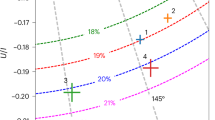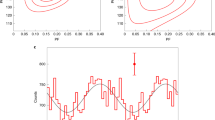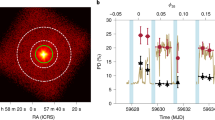Abstract
The Crab pulsar is a typical example of a young, rapidly spinning, strongly magnetized neutron star that generates broadband electromagnetic radiation by accelerating charged particles to near light speeds in its magnetosphere1. Details of this emission process so far remain poorly understood. Measurement of polarization in X-rays, particularly as a function of pulse phase, is thought to be a key element necessary to unravel the mystery of pulsar radiation2,3,4. Such measurements are extremely difficult, however: to date, Crab is the only pulsar to have been detected in polarized X-rays5,6,7,8 and the measurements have not been sensitive enough to adequately reveal the variation of polarization characteristics across the pulse7. Here, we present the most sensitive measurement to date of polarized hard X-ray emission from the Crab pulsar and nebula in the 100–380 keV band, using the Cadmium–Zinc–Telluride Imager9 instrument on-board the Indian astronomy satellite AstroSat10. We confirm with high significance the earlier indication6,7 of a strongly polarized off-pulse emission. However, we also find a variation in polarization properties within the off-pulse region. In addition, our data hint at a swing of the polarization angle across the pulse peaks. This behaviour cannot be fully explained by the existing theoretical models of high-energy emission from pulsars.
This is a preview of subscription content, access via your institution
Access options
Access Nature and 54 other Nature Portfolio journals
Get Nature+, our best-value online-access subscription
$29.99 / 30 days
cancel any time
Subscribe to this journal
Receive 12 digital issues and online access to articles
$119.00 per year
only $9.92 per issue
Buy this article
- Purchase on Springer Link
- Instant access to full article PDF
Prices may be subject to local taxes which are calculated during checkout



Similar content being viewed by others
Change history
27 March 2018
A Correction to this paper has been published: https://doi.org/10.1038/s41550-018-0425-0
References
Lyne, A. & Graham-Smith, F. Pulsar Astronomy (Cambridge Univ. Press, Cambridge, 2012).
Krawczynski, H. et al. Scientific prospects for hard X-ray polarimetry. Astropart. Phys. 34, 550–567 (2011).
Dyks, J., Harding, A. K. & Rudak, B. Relativistic effects and polarisation in three high-energy pulsar models. Astrophys. J. 606, 1125–1142 (2004).
Petri, J. Phase-resolved polarisation properties of the pulsar striped wind synchrotron emission. Mon. Not. R. Astron. Soc. 434, 2636–2644 (2013).
Weisskopf, M. C., Silver, E. H., Kestenbaum, H. L., Long, K. S. & Novick, R. A precision measurement of the X-ray polarisation of the Crab nebula without pulsar contamination. Astrophys. J. Lett. 220, L117–L121 (1978).
Dean, A. J. et al. Polarised gamma-ray emission from the Crab. Science 321, 1183–1185 (2008).
Forot, M., Laurent, P., Grenier, I. A., Gouiffes, C. & Lebrun, F. Polarisation of the Crab pulsar and nebula as observed by the INTEGRAL/IBIS telescope. Astrophys. J. Lett. 688, L29–L32 (2008).
Chauvin, M. et al. Observation of polarised hard X-ray emission from the Crab by the PoGOLite Pathfinder. Mon. Not. R. Astron. Soc. 456, L84–L88 (2016).
Bhalerao, V. et al. The Cadmium Zinc Telluride Imager on AstroSat. J. Astrophys. Astron. 38, 31 (2017).
Singh, K. P. et al. ASTROSAT mission. Proc. SPIE 9144, 91441S (2014).
Vadawale, S. V. et al. Hard X-ray polarimetry with Astrosat-CZTI. Astron. Astrophys. 578, A73 (2015).
Kuiper, L. et al. The Crab pulsar in the 0.75–30 MeV range as seen by CGRO COMPTEL. A coherent high-energy picture from soft X-rays up to high-energy gamma-rays. Astron. Astrophys. 378, 918–935 (2001).
Slowikowska, A. et al. High-time-resolution measurements of the polarization of the Crab pulsar at 1.38 GHz. Astrophys. J. 799, 70 (2015).
Slowikowska, A., Kanbach, G., Kramer, M. & Stefanescu, A. Optical polarisation of the Crab pulsar: precision measurements and comparison to the radio emission. Mon. Not. R. Astron. Soc. 397, 103–123 (2009).
Maier, D., Tenzer, C. & Santangelo, A. Point and interval estimation on the degree and the angle of polarization: a Bayesian approach. Publ. Astron. Soc. Pac. 126, 459–468 (2014).
Lyutikov, M., Komissarov, S. S. & Porth, O. The inner knot of the Crab nebula. Mon. Not. R. Astron. Soc. 456, 286–299 (2016).
Moran, P. et al. A recent change in the optical and γ-ray polarization of the Crab nebula and pulsar. Mon. Not. R. Astron. Soc. 456, 2974–2981 (2016).
Ruderman, M. A. & Sutherland, P. G. Theory of pulsars—polar caps, sparks, and coherent microwave radiation. Astrophys. J. 196, 51–72 (1975).
Arons, J. & Scharlemann, E. T. Pair formation above pulsar polar caps—structure of the low altitude acceleration zone. Astrophys. J. 231, 854–879 (1979).
Romani, R. W. & Yadigaroglu, I.-A. Gamma-ray pulsars: emission zones and viewing geometries. Astrophys. J. 438, 314–321 (1995).
Takata, J., Chang, H.-K. & Cheng, K. S. Polarisation of high-energy emission from the Crab pulsar. Astrophys. J. 656, 1044–1055 (2007).
Dyks, J. & Rudak, B. Two-pole caustic model for high-energy light curves of pulsars. Astrophys. J. 598, 1201–1206 (2003).
Kirk, J. G., Skjæraasen, O. & Gallant, Y. A. Pulsed radiation from neutron starwinds. Astron. Astrophys. 388, L29–L32 (2002).
Cerutti, B., Mortier, J. & Philippov, A. A. Polarized synchrotron emission from the equatorial current sheet in gamma-ray pulsars. Mon. Not. R. Astron. Soc. 463, L89–L93 (2016).
Bai, X. & Spitkovsky, A. Modeling of gamma-ray pulsar light curves using the force-free magnetic field. Astrophys. J. 715, 1282–1301 (2010).
Basu, R., Athreya, R. & Mitra, D. Detection of off-pulse emission from PSR B0525+21 and PSR B2045-16. Astrophys. J. 728, 157–166 (2011).
Lei, F., Dean, A. J. & Hills, G. L. Compton polarimetry in gamma-ray astronomy. Space Sci. Rev. 82, 309–388 (1997).
Elsner, R. F., O’Dell, S. L. & Weisskopf, M. C. Measuring x-ray polarization in the presence of systematic effects: known background. Proc. SPIE 8443, 84434N (2012).
Krawczynski, H. Analysis of the data from Compton X-ray polarimeters which measure the azimuthal and polar scattering angles. Astropart. Phys. 34, 784–788 (2011).
Chattopadhyay, T., Vadawale, S. V., Rao, A. R., Sreekumar, S. & Bhattacharya, D. Prospects of hard X-ray polarimetry with Astrosat-CZTI. Exp. Astron. 37, 555–577 (2014).
Chattopadhyay, T. et al. Prompt emission polarimetry of gamma ray bursts with ASTROSAT CZT-Imager. Preprint at https://arxiv.org/abs/1707.06595 (2017).
Vadawale, S. V. et al. In orbit performance of Astrosat CZTI. Proc. SPIE 9905, 99051G (2016).
Agostinelli, S. et al. Geant4: a simulation toolkit. Nucl. Instrum. Meth. A 506, 250–303 (2002).
Acknowledgements
This publication uses data from the AstroSat mission of the Indian Space Research Organisation (ISRO), archived at the Indian Space Science Data Centre (ISSDC). CZT-Imager is built by a consortium of institutes across India, including the Tata Institute of Fundamental Research (TIFR), Mumbai, the Vikram Sarabhai Space Centre, Thiruvananthapuram, ISRO Satellite Centre (ISAC), Bengaluru, Inter University Centre for Astronomy and Astrophysics, Pune, Physical Research Laboratory, Ahmedabad, Space Application Centre, Ahmedabad. Contributions from the vast technical team from all these institutes are gratefully acknowledged. Specifically, we would like to thank M. K. Hingar, A. P. K. Kutty, M. H. Patil, S. Sinha and Y. K. Arora (TIFR) for the CZT-Imager hardware fabrication; and K. S. Sarma, K. H. Navalgund, R. Pandiyan and K. Subbarao (ISAC) for project management and mission operation. The continued support from M. Annadurai and A. S. Kirankumar is gratefully acknowledged. This publication uses contemporaneous radio observations with the Ooty Radio telescope (ORT) and the Giant Metrewave Radio Telescope (GMRT), for which we thank P. K. Manoharan and M. A. Krishnakumar at ORT, and the GMRT staff, respectively. The GMRT and the ORT are operated by the National Centre for Radio Astrophysics of the TIFR. B.C.J. acknowledges support from DST-SERB grant EMR/2015/000515.
Author information
Authors and Affiliations
Contributions
S.V.V., T.C. and N.P.S.M. performed the polarization analysis and simulations. A.R.R., D.B., S.Sreekumar and S.V.V. developed the CZTI instrument. D.B., A.V. and N.P.S.M. produced the data pipeline. G.C.D. and R.M. helped construct the Crab pulse profile and provided critical input. S.Sreekumar, E.S., P.P. and P.V. provided the on-board software, including a crucial software patch. S.Seetha supported and managed the observation scheduling. V.B.B. provided the ground calibration and formatted the figures. B.P. provided important input, highlighting the importance of phase-resolved analysis. B.C.J. and A.B. carried out contemporaneous radio observations and provided the absolute pulse-phase references. All authors commented on the manuscript.
Corresponding author
Ethics declarations
Competing interests
The authors declare no competing financial interests.
Additional information
Publisher’s note: Springer Nature remains neutral with regard to jurisdictional claims in published maps and institutional affiliations.
Electronic supplementary material
Supplementary Information
Supplementary Figures 1–7, Supplementary Table 1 and Supplementary References
Rights and permissions
About this article
Cite this article
Vadawale, S.V., Chattopadhyay, T., Mithun, N.P.S. et al. Phase-resolved X-ray polarimetry of the Crab pulsar with the AstroSat CZT Imager. Nat Astron 2, 50–55 (2018). https://doi.org/10.1038/s41550-017-0293-z
Received:
Accepted:
Published:
Issue Date:
DOI: https://doi.org/10.1038/s41550-017-0293-z
This article is cited by
-
MeV astrophysical spectroscopic surveyor (MASS): a compton telescope mission concept
Experimental Astronomy (2024)
-
Simultaneous space and phase resolved X-ray polarimetry of the Crab pulsar and nebula
Nature Astronomy (2023)



